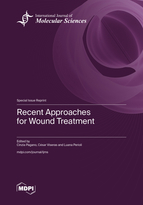Recent Approaches for Wound Treatment
A special issue of International Journal of Molecular Sciences (ISSN 1422-0067). This special issue belongs to the section "Molecular Pathology, Diagnostics, and Therapeutics".
Deadline for manuscript submissions: closed (15 January 2023) | Viewed by 26631
Special Issue Editors
Interests: pharmaceutical technology; drug delivery
Special Issues, Collections and Topics in MDPI journals
Interests: medicinal products; medical devices; pharmaceutical technology; drug delivery
Special Issues, Collections and Topics in MDPI journals
Interests: pharmaceutical technology; drud delivery systems
Special Issues, Collections and Topics in MDPI journals
Special Issue Information
Dear Colleagues,
Wounds represent an unsolved serious healthcare problem. The treatments available are not-satisfactory because they do not take into account the patient-to-patient differences and needs changing according to wound type as well as age, sex, etc. An efficacious therapy could be obtained by specific customized treatments developed taking into account the specific aspects of the patient.
The aim of this special issue is to describe the recent approaches for and efficacious treatment of wounds from different aspects. These include the description of new ingredients (e.g. A.P.I., polymers) able to stimulate the wound healing, new delivery systems, new formulations as well as new understanding in the stimulation of physiological biochemical pathways (that change according to many factors such as age, sex, etc.) involved in wound healing.
Dr. Cinzia Pagano
Prof. Dr. César Viseras
Dr. Luana Perioli
Guest Editors
Manuscript Submission Information
Manuscripts should be submitted online at www.mdpi.com by registering and logging in to this website. Once you are registered, click here to go to the submission form. Manuscripts can be submitted until the deadline. All submissions that pass pre-check are peer-reviewed. Accepted papers will be published continuously in the journal (as soon as accepted) and will be listed together on the special issue website. Research articles, review articles as well as short communications are invited. For planned papers, a title and short abstract (about 100 words) can be sent to the Editorial Office for announcement on this website.
Submitted manuscripts should not have been published previously, nor be under consideration for publication elsewhere (except conference proceedings papers). All manuscripts are thoroughly refereed through a single-blind peer-review process. A guide for authors and other relevant information for submission of manuscripts is available on the Instructions for Authors page. International Journal of Molecular Sciences is an international peer-reviewed open access semimonthly journal published by MDPI.
Please visit the Instructions for Authors page before submitting a manuscript. There is an Article Processing Charge (APC) for publication in this open access journal. For details about the APC please see here. Submitted papers should be well formatted and use good English. Authors may use MDPI's English editing service prior to publication or during author revisions.
Keywords
- wound healing
- inflammation
- infection
- biochemistry of repair and regeneration
- active ingredients
- wound dressings
- formulations







